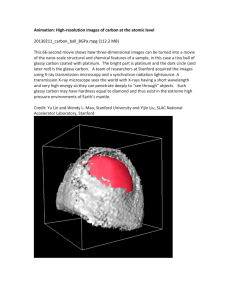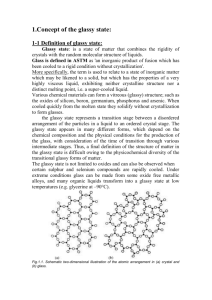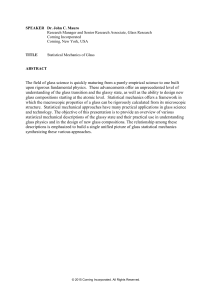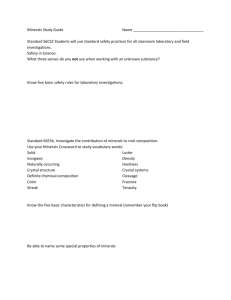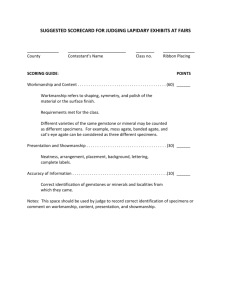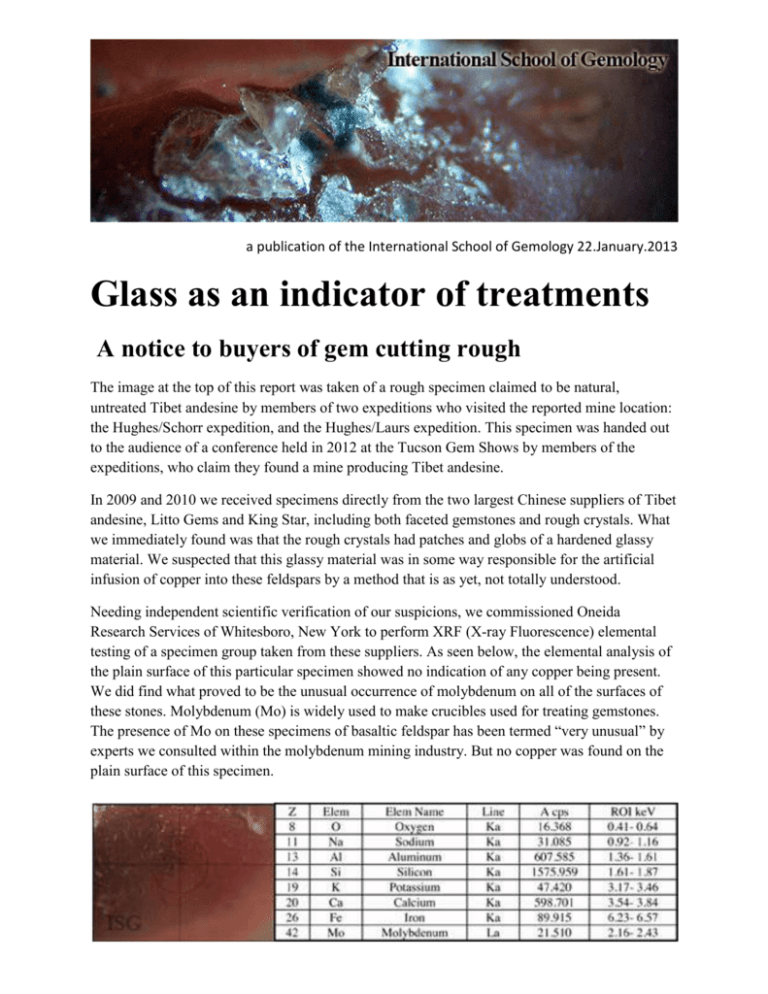
a publication of the International School of Gemology 22.January.2013
Glass as an indicator of treatments
A notice to buyers of gem cutting rough
The image at the top of this report was taken of a rough specimen claimed to be natural,
untreated Tibet andesine by members of two expeditions who visited the reported mine location:
the Hughes/Schorr expedition, and the Hughes/Laurs expedition. This specimen was handed out
to the audience of a conference held in 2012 at the Tucson Gem Shows by members of the
expeditions, who claim they found a mine producing Tibet andesine.
In 2009 and 2010 we received specimens directly from the two largest Chinese suppliers of Tibet
andesine, Litto Gems and King Star, including both faceted gemstones and rough crystals. What
we immediately found was that the rough crystals had patches and globs of a hardened glassy
material. We suspected that this glassy material was in some way responsible for the artificial
infusion of copper into these feldspars by a method that is as yet, not totally understood.
Needing independent scientific verification of our suspicions, we commissioned Oneida
Research Services of Whitesboro, New York to perform XRF (X-ray Fluorescence) elemental
testing of a specimen group taken from these suppliers. As seen below, the elemental analysis of
the plain surface of this particular specimen showed no indication of any copper being present.
We did find what proved to be the unusual occurrence of molybdenum on all of the surfaces of
these stones. Molybdenum (Mo) is widely used to make crucibles used for treating gemstones.
The presence of Mo on these specimens of basaltic feldspar has been termed “very unusual” by
experts we consulted within the molybdenum mining industry. But no copper was found on the
plain surface of this specimen.
When the Oneida scientists turned the XRF on the white glassy material, however, it was found
to contain verifiable amounts of copper, and once again molybdenum. Images are from the
Oneida report.
Most telling, however, was a glassy area that appeared to be burnt that now contained significant
levels of copper.
After receiving the specimens from the Hughes/Schorr expeditions, we inspected all of our
specimens for this glassy residue as seen below. We not only found the glassy residue, but also a
curious find that the glassy material often contained fibers. Below are two images from the
specimens from Litto Gems. The image on the left clearly shows that the glass formed alongside
something with a straight edge. Below right is a glass encased thread that is partly exposed.
Below you see images of specimens from King Star. The glassy material is clearly visible below
left, as part has been chipped off. At right is an area of glassy material where the edge has
chipped revealing the different material as the crystal. By Raman scan we are able to match this
material to those tested by Oneida Research Services.
And below is an image taken of a claimed natural Mongolian andesine from the Hughes/Schorr
conference. The hardened glassy material with embedded quartz crystals, along with glassy
encrusted threads, is clearly visible in this 10x microphotograph.
As previously reported, we had independent scientific analysis of the Hughes/Schorr specimens
done by FAI Materials Testing of Marietta, Georgia using a scanning electron microscope
(SEM). FAI reported a total lack of molybdenum on the Hughes/Schorr provided specimens.
Instead was found concentrations of sulfur and heat annealed graphite, the main constituents of
graphite crucibles used for gemstone treatments. We concluded that the treaters stopped using
the more expensive molybdenum crucibles when the Tibet andesine story was exposed, and
switched to the cheaper graphite crucibles as found on the Hughes/Schorr specimens.
While we do not fully understand the source of this glassy material on the surface of the Tibet
andesine, we are able to link this copper enriched glassy material on all of the specimens.
We have found other glassy materials on other
gemstones that demonstrate treatments. Next is our
study of glass filled corundum. At left are two ruby
specimens that have been fused together by hardened
sodium silicate, better known as water glass.
Water glass is used for a variety of purposes; most
popular among them is as a sealant for automobile
cooling systems. For cars with leaking cooling systems,
pouring water glass into the radiator allows the liquid
to circulate around the cooling system. When the
sodium silicate reaches a temperature of approximately
200°F it solidifies into a very hard glass sealing the
small cracks and leaks.
This provides an important clue to the issue of gemstone treatment when
water glass is found hardened on the surface because it requires a
temperature of around 200°F for it to harden in ambient atmospheric
pressure. We obtained a bottle of water glass and tested it in our kitchen
oven to verify this fact. Our bottle of sodium silicate is shown at right.
Based in what are now thousands of specimens that we have reviewed over the past four years,
we have found these same features on a variety of gemstones that show evidence of treatment,
but all from dealers from the same two locations: Thailand and China.
Below is a selection of these specimens for review.
Below left is the previously reported “color infused” aquamarine, and below right a 60x image of
an aquamarine specimen that was encased in hardened water glass so thick an encrusted thread
appeared to actually be inside the crystal.
From Thailand, we obtained the parcel of “Imperial Topaz” as seen below left. Below right is a
10x image of one of the specimens showing hardened water glass in a fissure in the stone, along
with a small rounded quartz crystal.
We also found the same features of hardened water glass and encrusted threads on dark, neon
blue apatite obtained from a Thai dealer. These stones suddenly appeared on the market in the
recent past and were previously unknown in the quantities and colors now seen.
We have also found this material on garnets and on tourmaline as seen below. The surface of this
tourmaline is heavily covered in hardened water glass with embedded threads as seen in the
center of the image.
Below is another view of this tourmaline crystal with a mass of thread impressions in the
hardened glass surface.
Previous testing commissioned by the ISG to the Evans Analytical Group Labs of Syracuse, New
York using LA-ICP-MS revealed “matrix” levels of iron in the green tourmalines tested, and
manganese in the pink tourmalines tested, both demonstrating these same characteristics of
surface encrustations of a glassy material of various formations.
Conclusion:
The presence of a glassy coating or patch on gemstones does not by itself create prima facie
evidence of color enhancement of a gemstone. However, given that temperatures of at least
200°F are required to harden water glass, it is reasonable to conclude that any gemstone with a
crust of hardened water glass has been subjected to some sort of treatment. If the glassy
substance is unknown but contains elements required to color treat a gemstone, as in the case of
Tibet andesine, it is also reasonable to conclude that the glassy substance could well be a
conduit, or some sort of flux, used in color treatment when only the glassy material contains the
elements and none are found naturally on the gemstone.
Based on the findings of Oneida Research Services and FAI Materials Testing regarding the
glassy material on the Tibet andesine, we do believe that this glassy substance is being used as
some sort of carrier for artificial coloring agents for gemstone color enhancement. The specific
equation required…we believe, varies from gemstone to gemstone, leaving no single answer for
the question of “how” it is done.
As a result of these findings, we urge great caution to anyone considering buying gemstone
rough, particularly from Thai and Chinese dealers that demonstrate the presence of hardened
glassy substances on the surface or in fissures in the stone. The mere presence of a glassy
material should be a strong indicator that the gemstone has been subjected to some form of
treatment. If no treatment is disclosed, then caution should be the word for buying decisions.
The treatment of gemstones, even color infusion using water glass or other glassy elements, is
not a negative issue unless the results are sold on the market without disclosure.
At this time, we believe that a significant amount of these color infused gemstones are being sold
on the market without disclosure.
We urge caution when purchasing any gemstone rough containing areas of hardened glassy
substances on the surface or in fissures.
Robert James
International School of Gemology
©2013 International School of Gemology. ALL RIGHTS RESERVED. We encourage sharing
and caring within the industry as long as all copyrights are left intact.

